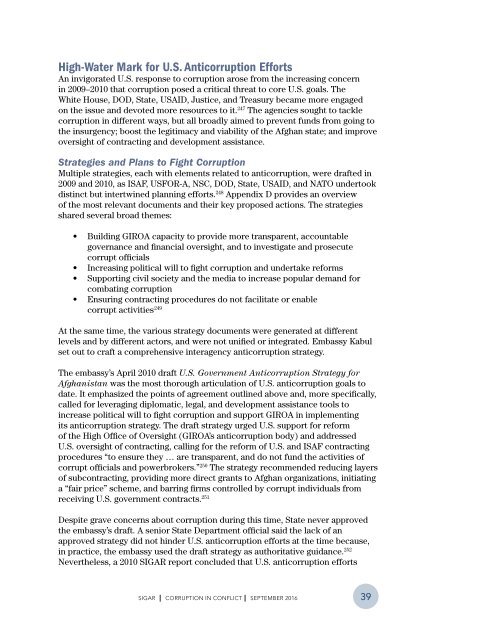CORRUPTION IN CONFLICT
5IlaWjQej
5IlaWjQej
Create successful ePaper yourself
Turn your PDF publications into a flip-book with our unique Google optimized e-Paper software.
High-Water Mark for U.S. Anticorruption Efforts<br />
An invigorated U.S. response to corruption arose from the increasing concern<br />
in 2009–2010 that corruption posed a critical threat to core U.S. goals. The<br />
White House, DOD, State, USAID, Justice, and Treasury became more engaged<br />
on the issue and devoted more resources to it. 247 The agencies sought to tackle<br />
corruption in different ways, but all broadly aimed to prevent funds from going to<br />
the insurgency; boost the legitimacy and viability of the Afghan state; and improve<br />
oversight of contracting and development assistance.<br />
Strategies and Plans to Fight Corruption<br />
Multiple strategies, each with elements related to anticorruption, were drafted in<br />
2009 and 2010, as ISAF, USFOR-A, NSC, DOD, State, USAID, and NATO undertook<br />
distinct but intertwined planning efforts. 248 Appendix D provides an overview<br />
of the most relevant documents and their key proposed actions. The strategies<br />
shared several broad themes:<br />
• Building GIROA capacity to provide more transparent, accountable<br />
governance and financial oversight, and to investigate and prosecute<br />
corrupt officials<br />
• Increasing political will to fight corruption and undertake reforms<br />
• Supporting civil society and the media to increase popular demand for<br />
combating corruption<br />
• Ensuring contracting procedures do not facilitate or enable<br />
corrupt activities 249<br />
At the same time, the various strategy documents were generated at different<br />
levels and by different actors, and were not unified or integrated. Embassy Kabul<br />
set out to craft a comprehensive interagency anticorruption strategy.<br />
The embassy’s April 2010 draft U.S. Government Anticorruption Strategy for<br />
Afghanistan was the most thorough articulation of U.S. anticorruption goals to<br />
date. It emphasized the points of agreement outlined above and, more specifically,<br />
called for leveraging diplomatic, legal, and development assistance tools to<br />
increase political will to fight corruption and support GIROA in implementing<br />
its anticorruption strategy. The draft strategy urged U.S. support for reform<br />
of the High Office of Oversight (GIROA’s anticorruption body) and addressed<br />
U.S. oversight of contracting, calling for the reform of U.S. and ISAF contracting<br />
procedures “to ensure they … are transparent, and do not fund the activities of<br />
corrupt officials and powerbrokers.” 250 The strategy recommended reducing layers<br />
of subcontracting, providing more direct grants to Afghan organizations, initiating<br />
a “fair price” scheme, and barring firms controlled by corrupt individuals from<br />
receiving U.S. government contracts. 251<br />
Despite grave concerns about corruption during this time, State never approved<br />
the embassy’s draft. A senior State Department official said the lack of an<br />
approved strategy did not hinder U.S. anticorruption efforts at the time because,<br />
in practice, the embassy used the draft strategy as authoritative guidance. 252<br />
Nevertheless, a 2010 SIGAR report concluded that U.S. anticorruption efforts<br />
SIGAR I <strong>CORRUPTION</strong> <strong>IN</strong> <strong>CONFLICT</strong> I SEPTEMBER 2016<br />
39


